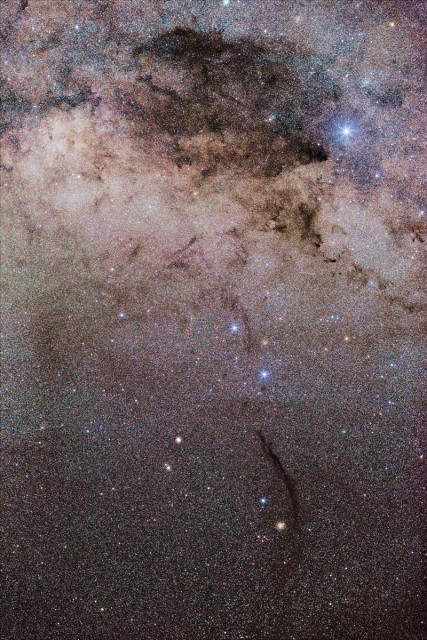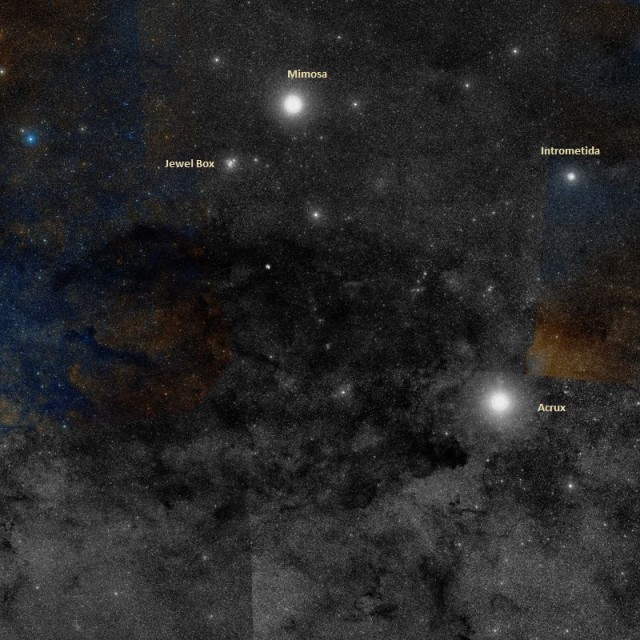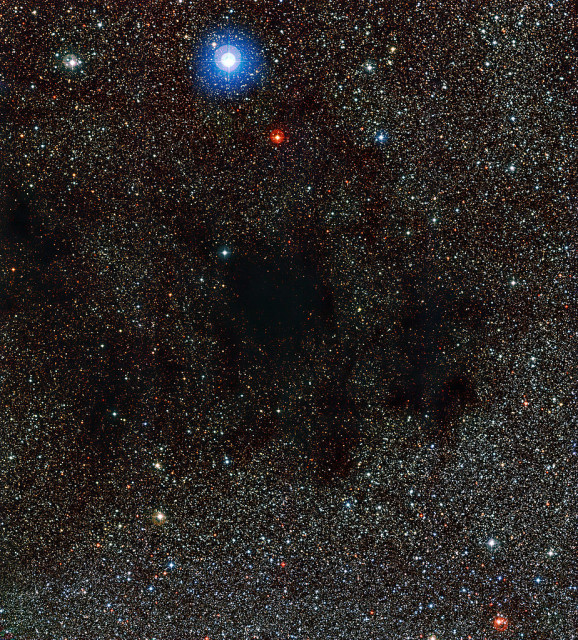The Coalsack Nebula is one of the best known dark nebulae in the sky, along with the nearby Dark Doodad Nebula and the Horsehead Nebula. The Coalsack is located in the southern constellation Crux and overlaps into the neighbouring constellations Musca and Centaurus.
The dark cloud of cold gas and dust lies at a distance of 600 light years from Earth and is about 30 to 35 light years across.
The Coalsack Nebula occupies an area of 7 by 5 degrees and is the most conspicuous object of its kind in the sky, barely fitting into a single binocular field of view.
The nebula’s darkness is the result of dust particles blocking the visible light of stars in the background. The little background starlight that can be seen through the thick dust clouds appears reddish because dust absorbs and scatters blue light more easily than red.
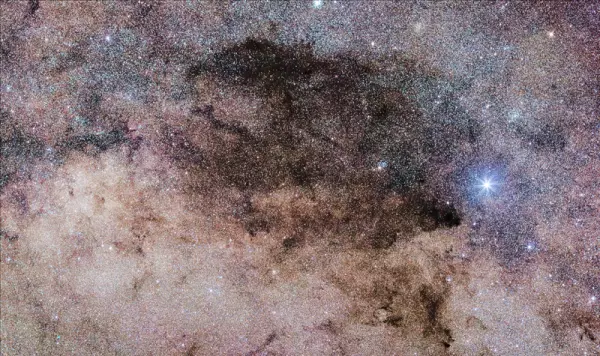
Coalsack Nebula, image: Wikimedia Commons/Naskies (CC BY-SA 3.0)
The Coalsack is easily visible to southern observers, appearing as a dark patch near the Southern Cross asterism and silhouetted against the star fields of the Milky Way. The nebula lies roughly between the bright star Acrux and the Jewel Box Cluster.

The Coalsack is one of the most prominent dark nebulae visible to the unaided eye. A beautiful sight in the southern sky, the Coalsack casts a dark silhouette against the Milky Way’s bright stripe of stars. The Coalsack is located approximately 600 light-years away from Earth in the southern part of the constellation of Crux (the Southern Cross). This seemingly starless dark patch is actually an opaque interstellar dust cloud that obscures the light of the background Milky Way stars. Dust grains in the cloud redden the starlight that reaches us by absorbing blue light preferentially, so that the red stars shimmering in the northern and darkest part of the Coalsack appear more crimson than they would in the absence of this dust. The first European to see this remarkable object was probably the Spanish navigator and explorer Vincente Yanez Pinzon when he sailed to the South American coast in 1499. The Coalsack earned the nickname “Black Magellanic Cloud” in the 16th century, apparently rivalling the prominence of the Large and Small Magellanic Clouds, the two dwarf irregular galaxies that shine brightly in the skies of the Southern Hemisphere. The Incas tell that the god Ataguchu, in a fit of temper, kicked the Milky Way and a fragment flew off, forming the Small Magellanic Cloud where it landed on the sky, and leaving the black mark of the Coalsack behind. Beware of Inca gods in a bad mood! Another famous sight seen from southern latitudes — though it can creep into view in tropical northern latitudes — is the Southern Cross, or Crux. This cross-shaped constellation has assumed great significance in the cultures of the Southern Hemisphere, even as far back as prehistoric times. So distinctive and evocative is the Southern Cross that the national flags of Australia, Brazil, New Zealand, Papua New Guinea, and Samoa all include a representation of it. The European Southern Observatory (ESO) has also acknowledged the significance of Crux as the foremost constellation of the southern skies, and has proudly incorporated the cross-shaped symbol into the ESO logo. Image: ESO/S. Brunier
The Coalsack Nebula was known in the southern hemisphere since prehistoric times. It was first seen by a European in 1499, when Spanish navigator and conquistador Vicente Yáñez Pinzón reported observing it during his voyage to South America.
Italian explorer Amerigo Vespucci called the nebula “il Canopo fosco,” or “the dark Canopus.“ The Coalsack was also known as the Black Magellanic Cloud or “Macula Magellani” (Magellan’s Spot), in reference to the Magellanic Clouds, bright dwarf galaxies visible in the southern sky.
Italian-born historian Peter Martyr d’Anghiera was the first to provide a formal description of the nebula between 1511 and 1521. Another description came from the French astronomer Nicolas Louis de Lacaille, who mapped the southern skies from the Cape of Good Hope and included a note about the Coalsack Nebula in an appendix to his 1755 catalogue.
Consisting of thick clouds of gas and dust – material used to form new stars – the Coalsack Nebula will not stay dark forever. Millions of years from now, parts of it will be illuminated by the light of young stars.
In 1970, Finnish astronomer Kalevi Mattila proved that the nebula is not completely black, but has 10% of the brightness of the surrounding Milky Way. The dim light comes from the reflection of stars the nebula obscures.
Observations of light extinction of the background stars have revealed that the Coalsack consists of two large overlapping clouds of dust located 610 and 790 light years from Earth.
In Australian Aboriginal astronomy, the Coalsack Nebula forms the head of the Emu in the Sky, an indigenous Australian constellation. The Emu’s neck can be seen between the Southern Pointers (Alpha and Beta Centauri) and its body stretches across Scorpius. Some indigenous groups also see the nebula as the top of a large pine tree that can be climbed into the sky, or as a deep hole in the celestial river represented by the Milky Way.
The Incas associated the Coalsack with the story of the god Ataguchu, who kicked the Milky Way in a fit of anger, causing a fragment to fly off and form the Small Magellanic Cloud. In the story, the Coalsack is the black mark left behind where the broken fragment was.
The Coalsack is identified as C99 in the Caldwell catalogue. It is not listed in the New General Catalogue and does not have a NGC number.
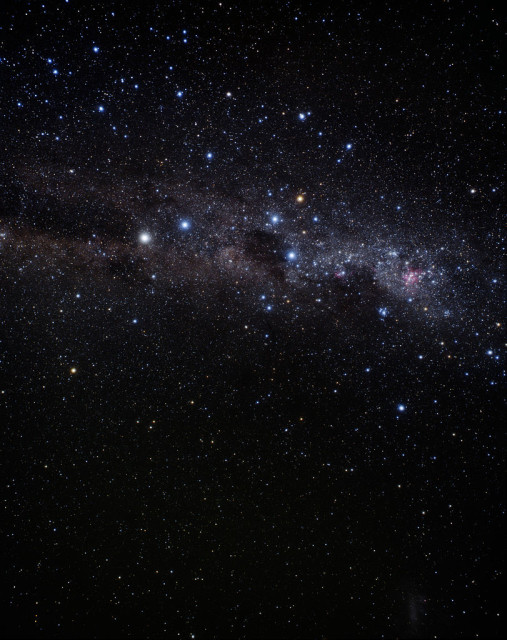
The Jewel Box is shown just right of center, above the dark nebula called the Coalsack in this picture of the southern sky. The picture was taken with a small ground-based camera. Image: A. Fujii
Coalsack Nebula
| Object: Dark nebula |
| Right ascension: 12h 50m |
| Declination: -62°30′ |
| Constellation: Crux |
| Apparent magnitude: – |
| Distance: 600 light years |
| Apparent size: 7 x 5° |
| Radius: 30 – 35 light years |
| Designations: Coalsack Nebula, C99, TGU H1867 |
